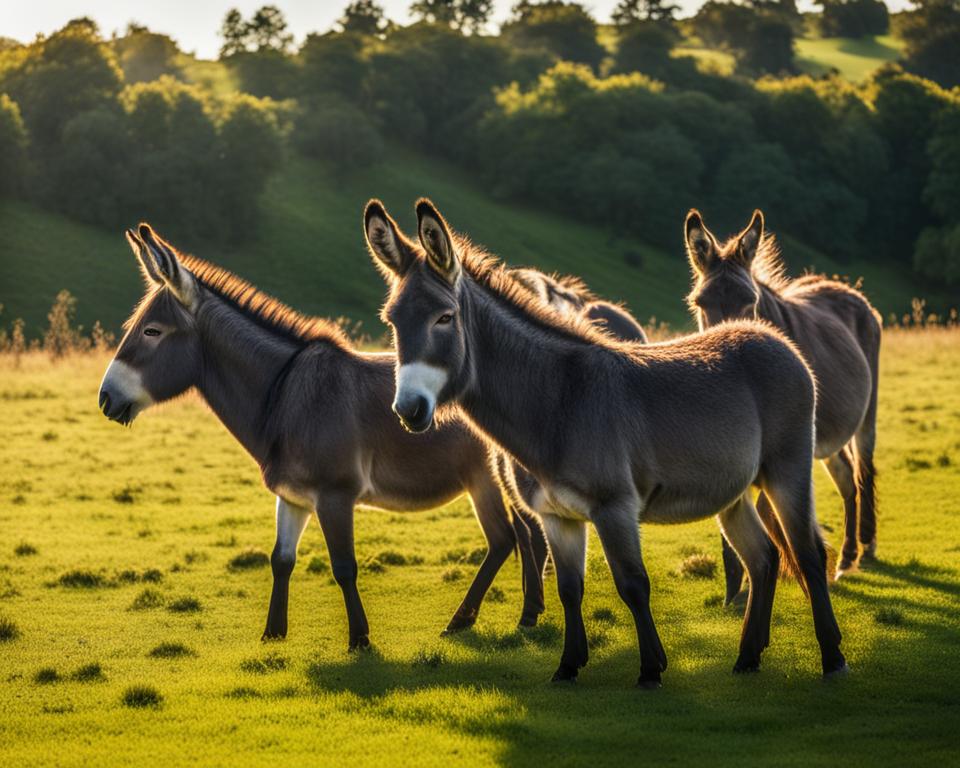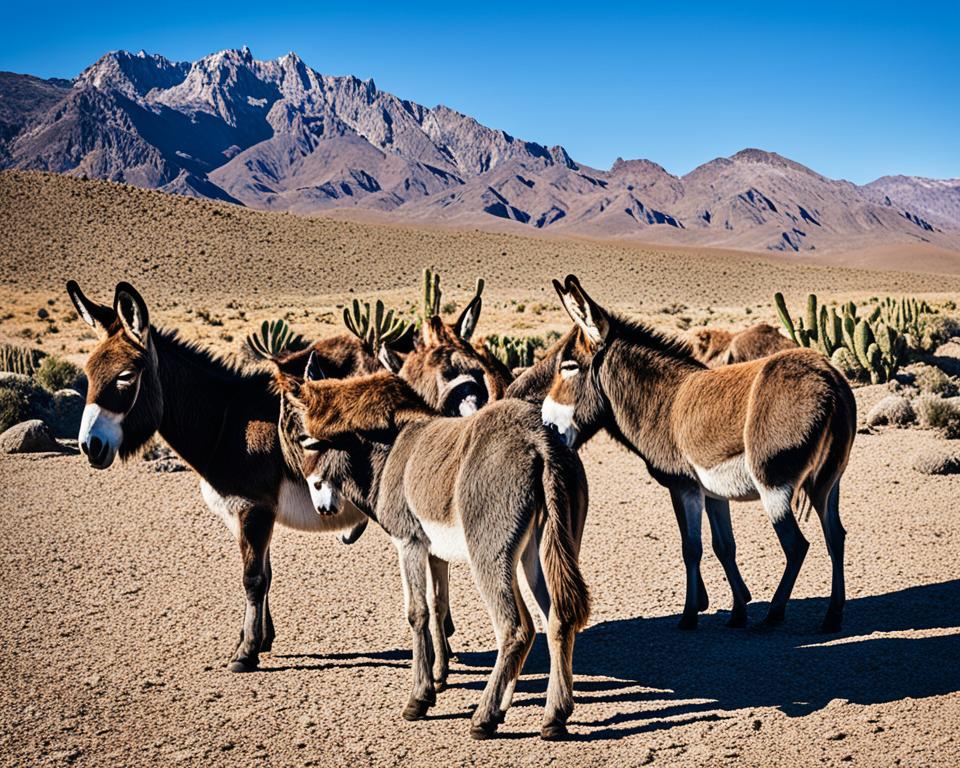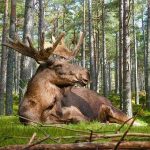As you delve into the world of donkey trivia, prepare to have your heart charmed by these adorable donkeys. Often overshadowed by their equine cousins, donkeys are fascinating creatures filled with interesting donkey facts that defy common misconceptions. From their pivotal role in history to their remarkable adaptability, these gentle animals harbor a wealth of surprises waiting to be uncovered.
Whether you’re an animal enthusiast or simply curious, the insights into donkey behavior, their distinct sounds, and the extraordinary ways they navigate their habitats will open your eyes to the depths of their charm. Join us as we explore the delightful nuances that make donkeys truly special members of the animal kingdom.
The Evolutionary Journey of Donkeys
Tracing the lineage of donkeys brings to light a fascinating evolutionary path that illustrates their adaptation and survival through millennia. Unveiling the story of donkey evolution provides insight into how these animals have come to be the enduring symbols of patience and resilience that we know today.
Ancestral Roots: From Asiatic and African Descent
Your understanding of donkeys’ past begins with their ancestral roots. Millions of years ago, horses and donkeys shared a common ancestor, ultimately evolving into two distinct species of wild asses. The Asiatic wild asses adapted to diverse environments stretching from the Red Sea to Tibet, while the African wild asses thrived in the arid landscapes of North Africa. These wild species laid the groundwork for the domesticated donkeys we are familiar with today.
Domestication: A 6,000-Year-Old Tale
The history of domesticated donkeys is as ancient as civilization itself, with the African wild asses’ offspring being tamed as far back as 6,000 years in regions like North Africa and Egypt, initially for their meat and milk. This marks the beginning of the domesticated donkeys history, serving humans ever since in various essential capacities.
The Donkey’s Silk Road Adventure
Imagine donkeys embarking on the illustrious Silk Road, a demanding journey over 4,000 miles. Their resilience and strength made them invaluable over the several years it took to traverse this ancient trade route. This extensive travel did not only serve the purpose of trade but also facilitated a mixing of breeds, thereby enriching the donkey evolution with a kaleidoscope of diverse breeds that are present to this day.
Movement and Breeding: Donkeys During the Roman Era
The Roman Army’s territorial expansions had a profound impact on the movement and breeding of donkeys. These sturdy animals were utilized extensively in agriculture and as pack animals, which led to their dissemination across Northern Europe. The expansion continued into England, marking another significant chapter in the journey of the domesticated donkeys history.
| Epoch | Geographical Region | Domestication Purpose | Influence on Breeding |
|---|---|---|---|
| Ancient Times | North Africa, Asiatic Regions | Meat and Milk | Initial Domestication |
| Silk Road Era | China to Mediterranean | Trade and Transport | Mixed Breeds Emergence |
| Roman Empire | Europe and Britain | Agriculture and Logistic Support | Spread into Northern Europe |
The Unique Physiology of Donkeys
As you delve deeper into the world of donkeys, you’ll quickly notice that these resilient creatures have a physiology unlike any other. One of the most striking features is their large ears, which have evolved not just for an impressive auditory range but also play a crucial role in their survival. Let’s explore how the physiology of donkeys is perfectly adapted to arid landscapes where they originate from.
Understanding donkey physiology is key to appreciating these animals beyond their traditional roles. Interestingly, their large ears aren’t just for acute hearing, which allows them to detect sounds from herd mates and potential predators from miles away. The ears are also marvels of natural engineering when it comes to dealing with the heat. In the scorching climates of their native habitats, this biological feature is a lifesaver.
Due to the larger surface area, donkey ears are adept at heat dissipation, a vital mechanism that prevents them from overheating. As blood flows through the extensive network of blood vessels in the ears, excess heat is expelled, helping to regulate the donkey’s body temperature effectively even in extreme heat.
Donkeys’ large ears are not an aesthetic accident but a masterstroke of adaptation that allows them to thrive in harsh environments, where both keen hearing and the ability to remain cool are indispensable.
- Their ears act like natural radiators, expelling heat and cooling the blood as it circulates through the extensive capillary network.
- The ability to detect sounds over long distances is crucial for communication within their widely dispersed herds in the vast desert terrain.
- One could argue that a donkey’s ears are among the most multi-functional and impressive auditory apparatuses in the animal kingdom.
Your appreciation for these animals will deepen as you learn more about the physiology of donkeys, which enables them to survive and flourish in environments that many other species find inhospitable. The next time you see those distinctive ears, you’ll understand they’re not just listening – they’re expertly managing life in the heat.
Understanding Donkey Behavior and Communication
If you’ve ever found yourself in the presence of a donkey, you may have been greeted by a chorus of distinctive brays. Understanding the nuances of donkey communication sheds light on their social structure and emotional world. But there’s more to their behavior than just the sounds they make, as a donkey’s large ears play a role in more than just auditory cues. Let’s explore these facets of donkey life that exemplify their adaptability and sociability.
The Significance of Braying
The iconic sound of a donkey braying is not just a call into the wilderness—it’s a language of its own. Donkey behavior centers around braying, a key to their communication repertoire unique among equids. They demonstrate their vocal prowess by braying both during inhalation and exhalation, creating the classic “hee-haw” that resonates across the landscape. Each individual donkey has its own distinct pattern of braying, revealing their state of mind, calling to peers across vast distances, or even warning others of potential threats. This ability to produce such a varied range of vocalizations is a fascinating aspect of donkey senses and communication.
Clever Ears: More Than Just Hearing
A donkey’s large ears are a biological marvel, playing a multifaceted role that combines auditory sensitivity with thermoregulation. Their oversized ears give them an extraordinary ability to hear sounds far beyond human capability, which is essential for donkey behavior particularly in their natural habitat, where distances between individuals can be great. As a result, donkey communication relies not only on their ability to vocalize but also on their keen hearing to maintain herd cohesion.
Yet, their ears serve a dual purpose. In arid and hot environments, the same large surface area that captures sound also helps to dissipate heat, thereby assisting in cooling their bodies. This dual functionality of their ears reveals a complexity in donkey senses that is often overlooked but vital for their survival in harsh climates.
As you get to know these intelligent creatures, you’ll find that every aspect of their existence, from the sounds they make to the way they’re constructed, is a testament to their adaptability and charm. Braying and their large, attentive ears are just the beginning of the wonders that donkeys have to share with us.
Poitou Donkeys: An 18th Century Treasure
Embark on a historical journey to discover the Poitou donkeys, a majestic and rare donkey breed cherished for its distinctive appearance and historical significance. Originating from the French Poitou region during the 18th century, the Poitou donkey, with its shaggy coat of thick mats known as ‘cadenettes,’ stands as a living testament to the rich tapestry of mule breeding history.

Once the backbone of European mule production, the mighty Poitou donkey’s existence became precarious as modernization led to a sharp decline in mule breeding. By 1977, the population of these gentle giants had dwindled to a mere 44 individuals, pushing the breed to the brink of extinction. Faced with this critical situation, animal preservationists rallied to safeguard the future of one of the world’s most rare donkey breeds.
Your fascination with Poitou donkeys is not without reason. As a pivotal contributor to the creation of sturdy, reliable mules, Poitou donkeys were an indispensable part of agricultural practices and transportation. Thanks to dedicated conservation efforts, the numbers of these endearing creatures have steadily increased, giving hope to their continued presence in our world.
The sweet-natured Poitou donkey, with its rich heritage and rescue from near oblivion, reminds us of the resilience of nature and the enduring human spirit that cherishes it.
A renewed interest in their conservation has not only uplifted the Poitou’s plight but has also reignited a passion for the timeless tradition of breeding mules. By contributing to the resurgence of this living legacy, you partake in a story of recovery that brings with it a renewed appreciation for diversity within equine heritage.
- The unique cadenettes are not just a symbol of beauty but were historically an indicator of the donkey’s capacity for mule breeding.
- Conservation efforts serve as a beacon of hope for other rare asinine breeds on the verge of disappearing.
- Your awareness and support can drive further action to preserve the heritage and biological diversity of the Poitou donkeys and beyond.
Protecting the Lineage: The African Wild Ass
As the origin of our domesticated donkeys, the African wild ass has a lineage that is the cornerstone of our agricultural and historical narrative. Yet today, these incredible creatures stand on the precipice of extinction, the consequence of relentless threats. Your understanding and action are pivotal in the fight to protect these endangered species, emphasizing the gravity of their plight and our collective role in their preservation.
Critical Endangerment: A Call for Action
The African wild ass faces challenges that put their very existence in jeopardy. Unregulated hunting and fierce competition with domestic livestock for scarce water resources have led to alarmingly low numbers in the wild. As stewards of the planet, it falls upon us to recognize their critical endangerment and push for measures that can change their course from vanishing to thriving. Delve deeper, and you’ll realize how vital conservation is to safeguard the legacy of these noble creatures that are part of Africa’s natural heritage.
Conservation Efforts: A Global Focus
International wildlife authorities and conservationists are banding together, orchestrating global efforts to protect the African wild ass. Legislation in Eritrea and Ethiopia stands as a testament to progressing acknowledgment and protection measures. But more is needed. Conservation strategies, such as those devised by the Convention on the Conservation of Migratory Species of Wild Animals (CMS), are comprehensive and culminate in action plans specific to each remaining population’s needs. These strategies, coupled with the establishment of natural reserves, formulate a blueprint for recovering the African wild ass populations one step at a time.
Here’s how you can be part of the solution:
- Support breeding programs that aim to reintroduce genetic diversity back into the wild, ensuring the resilience of future generations.
- Learn about and advocate for stronger conservation legislation within your own community and on a global scale.
- Spread awareness about the African wild ass, sharing the profound impact of poaching and habitat loss, and contribute to a discourse that prioritizes the survival of endangered species.
Your active engagement with conservation initiatives gives hope to the African wild ass, allowing them to remain an integral part of the diverse tapestry of life on Earth.
Hybrid Vigor: Donkeys and Their Offspring
As you explore the diverse world of donkey breeds, you may find the concept of donkey hybrids particularly intriguing. Known for their robustness and utility, hybrids like mules and hinnies emerge from the donkey’s close kinship with horses. Unique among their kind, zebra-donkey hybrids, such as zonkeys and zebra hinnies, captivate with their striking appearance and rarity.
What makes these crossbred creatures so exceptional? It’s their inherent hybrid vigor, which combines the strengths of two species into one. However, it’s important to note that almost all hybrids are sterile, meaning they cannot produce offspring of their own. This sterility is a biological safeguard to maintain the integrity of species, yet it doesn’t diminish the value these hybrids contribute to various human activities.
Take a moment to consider the mule, a workhorse of history, born from the union of a male donkey and a female horse. Famed for its endurance, intelligence, and less finicky dietary needs compared to horses, mules have been the backbone of agricultural and transportation endeavors for centuries. On the other side, hinnies—the result of a female donkey and male horse—are less common but equally as hardy and adaptive.
Now, let us turn our attention to the fascinating world of zebra-donkey hybrids. With names as whimsical as their appearance, zebra hinnies, zebroids, zebrasses, and zedonks capture the public imagination. While they are a rare sight, these creatures showcase the genetic compatibility between donkeys and zebras, adding an exotic flair to the already rich tapestry of donkey hybrids.
Your understanding of these hybrid animals isn’t just a testament to curiosity; it’s also an appreciation for the remarkable genetic legacy donkeys carry. Whether plowing fields or becoming a heartwarming exhibit in a zoo, these donkey hybrids stand out for their resilience and the distinctive role they play in showcasing nature’s versatility.
Even though they are unable to continue their lineage, mules, hinnies, and zebra-donkey hybrids serve as living proof that the merging of species can result in incredibly capable creatures. Their robust nature continues to serve humans in numerous ways, perpetuating a legacy of cross-species breeding that highlights the donkey’s unassuming yet immense contribution to our shared history. From the labor-intensive fields to modern-day educational and conservation efforts, the story of these animals is far from a mere footnote—it’s a narrative rich with inter-species cooperation and mutual benefit.
The Social Dynamics of Donkeys
Donkeys exhibit fascinating social behaviors, making their interactions a key topic in understanding their way of life. From creating long-lasting pair bonds to acting as protective guardians for other animals, these endearing equines demonstrate a complex social structure that is both heartwarming and admirable.
Establishing Bonds: Donkey Friendships
At the heart of donkey social behavior is the formation of deep pair bonds, indicative of their preference for strong social ties. Donkeys do not thrive in solitude; instead, they seek out and maintain close relationships with specific companions. These pair bonds are so integral to their well-being that when broken, donkeys may experience acute stress, manifesting as pining behavior or loss of appetite. Recognizing these pair bonds is crucial in ensuring the emotional and mental health of donkeys, especially when managing them in domestic settings.
The Guardian Role: Donkeys as Protectors
More than just social companions, donkeys can assume the role of livestock guardians, providing protection to flocks of sheep and herds of goats. Their natural aggression towards canids—an instinctive trait manifested from their evolutionary history—makes them particularly effective against threats such as dogs, coyotes, and foxes. The presence of a guardian donkey in a pasture can deter predators, often by their sheer presence and at times by confronting intruders if they approach. It is this protective instinct that has made donkeys an asset in pastoral farming, helping to safeguard the welfare of other livestock.
- Donkeys prefer to be with at least one companion and can form friendships that last a lifetime.
- The breaking of a pair bond can lead to visible signs of distress in donkeys.
- Donkeys’ effectiveness as livestock guardians is rooted in their inherent behavior to repel canid predators.
Debunking Myths: The Intelligence of Donkeys
When you think of donkeys, the term ‘stubbornness’ might spring to mind, but have you considered that this trait could be an indicator of intelligent self-preservation rather than a lack of cooperation? Donkeys exhibit a deeply rooted survival instinct, often misinterpreted as simple obstinacy, which actually reveals their nuanced intelligence.
Misunderstood Stubbornness: A Survival Tactic
Donkeys have long been labeled as stubborn creatures, yet this reputation masks a sophisticated risk assessment behavior. Donkeys exhibit what is known as ‘stubborn behavior’ when they are unsure of a situation. Unlike other animals that might react impulsively, donkeys take a moment to evaluate their surroundings before proceeding. This careful deliberation allows them to protect themselves from potential harm, exemplifying a powerful instinct for self-preservation and a reflection of donkey intelligence.
It’s not stubbornness; it’s smart survival. Donkeys prefer to assess their environment and make calculated decisions to ensure their safety, a trait that is reflective of their intelligence, not defiance.
Donkeys vs. Horses: Behavioral Comparisons
The contrast between donkey and horse behavior is quite distinct, especially when it comes to their reaction to threats. Horses possess a flight response—they quickly bolt when faced with danger. Donkeys, on the other hand, will often ‘freeze’ and evaluate whether flight is necessary. This is where stubborn behavior may be witnessed, but it is this very behavior that showcases their sophisticated sense of self-preservation. Such behaviors underline the cognitive abilities of donkeys and highlight their unique approach to life’s challenges.
Your understanding of these equine behaviors is essential in appreciating the true nature of donkeys. Recognizing their intelligent, thoughtful approach to danger, rather than misjudging it as mere obstinacy, can transform how we perceive and interact with these remarkable animals. Embracing this fact can lead to deeper, more respectful relationships with our long-eared friends, ensuring that we meet their needs and acknowledge their inquisitive minds.
- Donkey behavior is a complex mix of caution and curiosity, underpinned by an intelligent survival tactic.
- Distinguishing between donkeys and horses can enhance our approach to their care and understanding.
- Appreciating donkeys’ thought processes promotes a more nuanced view of their adaptation and intelligence.
Miniature Miracles: The World of Tiny Donkeys
Step into the enchanting realm of miniature donkeys—endearingly compact equines that capture the hearts of all who meet them. Native to the Mediterranean islands of Sicily and Sardinia, these tiny donkeys embody a perfect blend of cuteness and practicality within their small frames. As you explore more about these little wonders, you’ll be amazed by how their petite stature belies their big personalities and charm.
The Charm of Small Stature
Despite standing no taller than three feet at the shoulder, miniature donkeys are renowned for their gentle nature and friendly dispositions. These tiny donkeys are often considered ideal companions due to their docile temperament, making them perfect for small farms, petting zoos, and as beloved pets. They are more than just adorable; their diminutive size makes them easier to manage, and they require less space and food than their larger counterparts—which only adds to their allure.
Record-Holders: The Smallest Donkeys
In the fascinating echelons of tiny donkeys come those who hold prestigious world records for their size. KneeHi, a miniature donkey who stood mere 25.29 inches tall, is one of the smallest registered donkeys, placing these charming creatures on the map for their remarkable dimensions. Their size not only makes them captivating curiosities but also places them upon a pedestal within animal lover communities and record books alike.
Your own journey through the world of miniature donkeys will likely be as delightful as the animals themselves. These pint-sized creatures may be small, but their ability to leave a lasting impression on the hearts of those they meet is truly monumental. Whether it’s marveling at their compact form or learning about their surprising records, tiny donkeys undoubtedly hold a special place in the spectrum of adorable equines.
Donkey Habitats: From Arid Deserts to Domestic Life
Exploring the environments donkeys call home reveals a distinct contrast between the wide open spaces of arid deserts and the adaptability of these creatures to the domestic settings arranged by human companionship. The survival capabilities of donkeys in their natural habitats showcase impressive adaptation, while the nurturing conditions of domestic life highlight their versatile nature in adjusting to various climates and terrains. Stepping into the world of donkeys, you’re able to witness their journey from wild ancestors to cherished members of the agricultural community.
Natural Habitats and Behavior
Wild donkeys, known for their resilience, inhabit the challenging landscapes of deserts and savannas across regions like Africa, the Arabian Peninsula, and parts of Asia. Here, they display behaviors optimized for survival in extreme conditions—conserving energy by resting during the peak heat of the day and becoming more active when temperatures drop during the cooler mornings and evenings. This instinctual pattern of activity helps wild donkeys effectively manage their resources and navigate the spacious, often rugged terrain they occupy.

Feral vs. Domesticated: Size Differences
The transition from the expansive wilderness to the confines of domestic life has brought about a diverse array of domesticated donkeys, bred to various sizes to suit different human needs. Indeed, a size comparison between feral and domesticated donkeys illustrates how selective breeding has influenced their physical attributes. Feral donkeys, while robust, tend to be larger, maintaining the size necessary to thrive in unforgiving wild donkey habitats. Domesticated varieties, on the other hand, can range from the diminutive miniature donkey to the much larger mammoth stock, depending on the functions they are bred for.
| Donkey Type | Average Height (from hoof to shoulder) | Average Weight |
|---|---|---|
| Wild Donkey | 49 inches (125 cm) | 551 pounds (250 kg) |
| Domesticated Donkey | 36 to 48 inches (92 to 123 cm) | 400 to 500 pounds (180 to 225 kg) |
| Miniature Donkey | Up to 36 inches (92 cm) | Less than 400 pounds (180 kg) |
| Mammoth Stock Donkey | 56 inches (143 cm) | About 950 pounds (430 kg) |
As you examine the living conditions of these steadfast animals, whether roaming free in the vastness of the desert or serving as a dependable part of farms worldwide, it becomes evident that donkeys have dutifully earned their place alongside humans. From the wild stretches of their ancestral lands to the pastures they now often call home, donkeys continue to demonstrate an incredible ability to adapt and thrive, echoing a story of resilience and partnership that spans across continents and centuries.
Donkey Diets: What Fuels These Hardy Creatures
When considering a donkey diet, it’s fascinating to observe their food consumption and grazing behavior. As creatures well-adapted to the environments they inhabit, donkeys are voracious eaters with a plant-based diet that fuels their robust nature. These hardy animals primarily graze on grass, though they are known to consume shrubs and desert plants when the usual greens are scarce.
Your insight into the donkey diet reveals a careful balancing act between nourishment and resource management. Donkeys’ efficient way of eating allows them to thrive on high-fiber, low-protein vegetation that could be considered inadequate for other grazers. This ability underscores their minimalistic approach to food consumption and highlights their adaptability.
Did you know? A donkey can consume as much as 6,000 pounds of food per year. Their grazing behavior is not only integral to their well-being but also impacts the ecosystems they inhabit, especially in the case of feral donkey populations.
Understanding the dietary needs of donkeys is critical for their care. Whether domesticated or in the wild, the food consumption habits of donkeys play a pivotal role in their health and the health of their habitat. Here’s a look at the key components that constitute a typical donkey diet:
| Food Type | Role in Diet | Benefits | Considerations |
|---|---|---|---|
| Grasses | Primary Source | High fiber, aids digestion | Quality varies by season and region |
| Legumes | Supplemental Source | Protein and mineral enrichment | Should be limited to prevent obesity |
| Shrubs/Desert Plants | Alternative Source | Diversity in diet, essential in arid habitats | May contain components that are harmful in high quantities |
| Browse (Leaves, Twigs) | Secondar Source | Nutritional variety, dental health | Availability may depend on environment and climate |
As we’ve seen, the grazing behavior of donkeys is quite dynamic and plays a crucial role not only in their survival but also in maintaining the balance of their ecosystems. By consuming plant matter that other animals may bypass, donkeys contribute to biodiversity and landscape management.
Whether you are a donkey owner or an animal enthusiast, understanding and respecting the dietary requirements of these creatures fortifies your ability to ensure their welfare. Next time you observe these animals calmly grazing, remember that their diet is an integral part of their successful survival strategy—one that has been refined over millennia.
The Mating Game: Donkey Breeding and Reproduction
Step into the intricate world of donkey reproduction, where the survival of these beloved animals is perpetuated through a complex dance of nature. Breeding practices for donkeys are as varied as they are fascinating, including not only traditional mating but also inter-species unions that yield hardy and increasingly valued hybrids. Here, we explore the captivating lifecycle from conception to foal.
Inter-Species Breeding: Creating Hybrids
Donkeys boast impressive flexibility in their breeding habits, often forming crosses with horses and even zebras. These inter-species matings have given rise to an assortment of hybrids that are celebrated for their strength, endurance, and distinctive appearances. The mule, a hybrid offspring of a male donkey and female horse, stands out as a remarkably sturdy and intelligent work animal. Meanwhile, the zonkey—a zebra and donkey mix—is revered for its unique stripes and playful nature.
It is these hybrids that often embody the pinnacle of donkey reproductive achievements. While typically sterile and unable to further their own lineage, their existence highlights the genetic malleability within the Equidae family and underscores the role of selective breeding practices in shaping animal husbandry over the centuries.
Gestation and Foals: Donkey Reproductive Facts
Your understanding of donkey breeding deepens as we delve into the specifics of pregnancy and birth. Female donkeys endure a gestation period that lasts approximately 12 months, culminating in the birth of a single foal. These young donkeys are quite developed at birth, capable of standing and nursing within mere minutes after entering the world—a feature that highlights their resilience and adaptability.
As the foals grow, reaching sexual maturity at the age of 2, they carry on the genetic heritage of their parents. It is in these critical early years that they solidify their place within the herd and prepare for their eventual role in the breeding cycle. This period of growth further cements the importance of responsible breeding practices within the donkey community, ensuring both the health of individual animals as well as the species as a whole.
Whether you’re involved in equine care or simply an enthusiast, there’s no denying the intrinsic value and sheer wonder found within donkey reproduction and breeding. As caretakers of these gentle equines, it’s incumbent upon us to foster their well-being through informed and compassionate breeding practices, safeguarding the legacy of this extraordinary species for generations to come.
A Peek into Donkey Taxonomy
Embarking on a journey to understand donkeys deeper, let’s explore the fascinating world of donkey taxonomy. Within the broad and varied Equidae family, donkeys hold a distinct place, showcasing an array of species each with unique characteristics and adaptations that have enabled them to survive across diverse habitats around the globe.
Defining the Species: A Scientific Perspective
Donkeys, much loved for their hardworking nature and distinctive appearance, are scientifically recognized as part of the Equidae family. This family also encompasses their equine relatives – the horses and zebras. As members of the genus Equus, donkeys are classified into various species and subspecies, each with a traceable lineage that echoes their evolutionary history. The tapestry of their genetic makeup is as rich as the cultural stories they trot through.
| Species/Subspecies | Common Name | Geographical Distribution |
|---|---|---|
| Equus africanus | African Wild Ass | Eastern Africa |
| Equus hemionus | Asiatic Wild Ass | Central Asia |
| Equus asinus | Domestic Donkey | Worldwide |
| Equus africanus somaliensis | Somali Wild Ass | Horn of Africa |
Endangered Status: Preserving Donkey Diversity
In contrast to the domestic donkey populations that thrive under human care, their wild counterparts such as the African and Asiatic wild asses confront dire scenarios of existence. With the African wild ass critically endangered, the window to protect these keystone species is narrowing. Preserving the genetic diversity inherent to the Equidae family is not just about protecting a single species; it’s about ensuring the continuity of an entire ecological narrative.
As stewards of the environment, your awareness and support for conservation efforts can make a profound difference in the fate of these ancient creatures. We share a world where every living being plays a part in the complex web of life, and safeguarding endangered donkeys is a testament to our commitment to this intricate and beautiful diversity.
Conclusion
As we reach the finale of our journey through the world of donkeys, it becomes clear that these adorable equines are far more than meets the eye. Their evolution from ancient ancestors to today’s beloved companions reveals a history as rugged and enduring as the animals themselves. Understanding donkeys in this light allows us to see them not just as beasts of burden but as nuanced beings, brimming with personality and intelligence.
Reflecting on What Makes Donkeys Special
Donkeys possess an undeniable charm that endears them to those who encounter these gentle animals. With ears attuned to the softest rustle and brays distinct as a fingerprint, they hold a special place in the animal kingdom. Their ability to form deep social bonds and their underestimated intelligence only add to the unique character of these adorable equines. Donkeys are not merely survivors; they are thrivers, flourishing in environments as demanding as the arid deserts they originally inhabited.
The Importance of Understanding and Protecting Donkeys
Protecting the legacy of donkeys is crucial—not just for the sake of historical sentiment but for the ongoing benefits they provide in agriculture and safeguarding livestock. Donkey conservation is essential for maintaining the biodiversity and ecological balance of their native habitats as well. As stewards of the earth, your role in fostering an environment of care and respect for these animals can make a profound difference. So as we continue to coexist with these stoic creatures, let’s pledge to deepen our understanding of donkeys and commit to ensuring their future remains as steadfast as their past.











